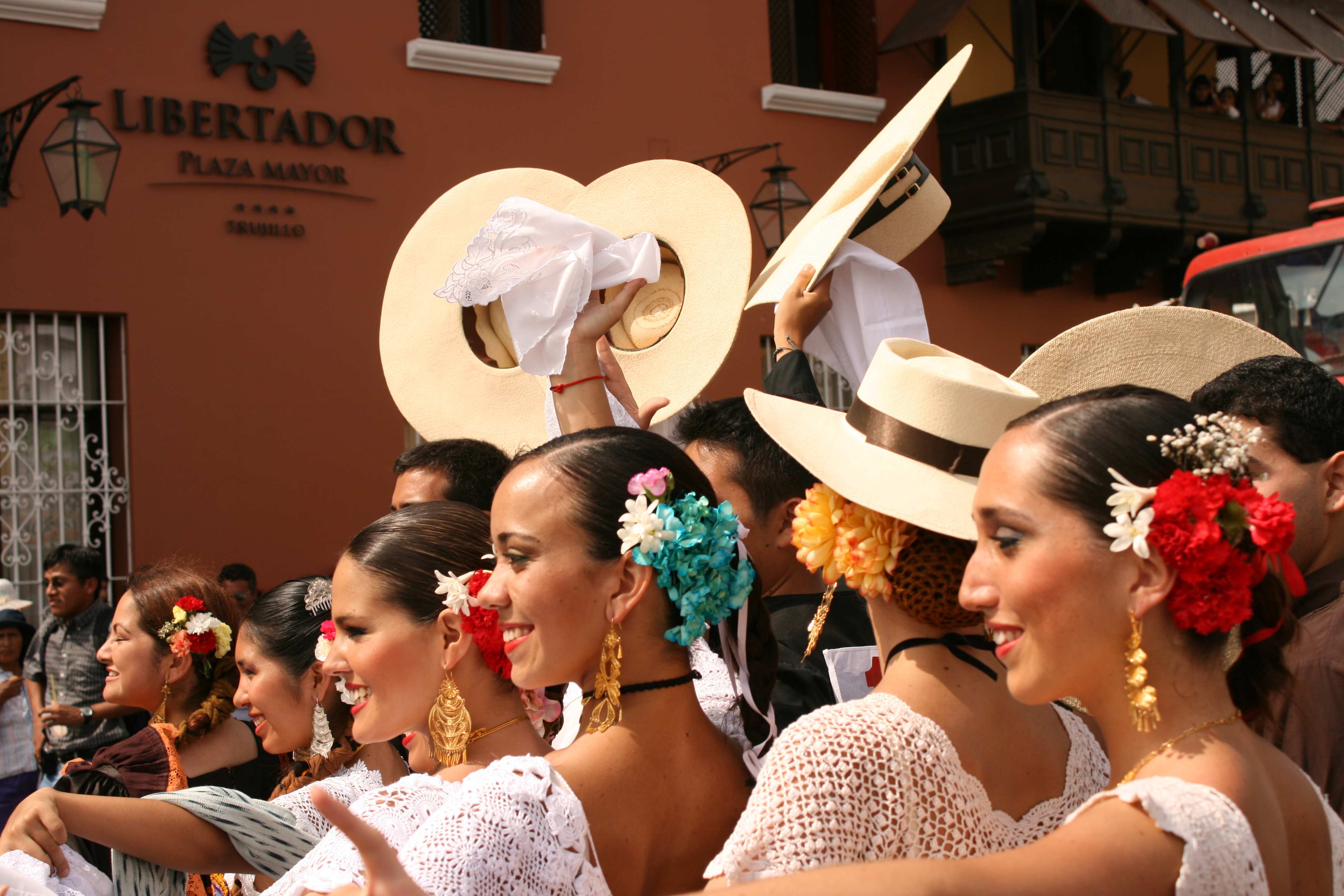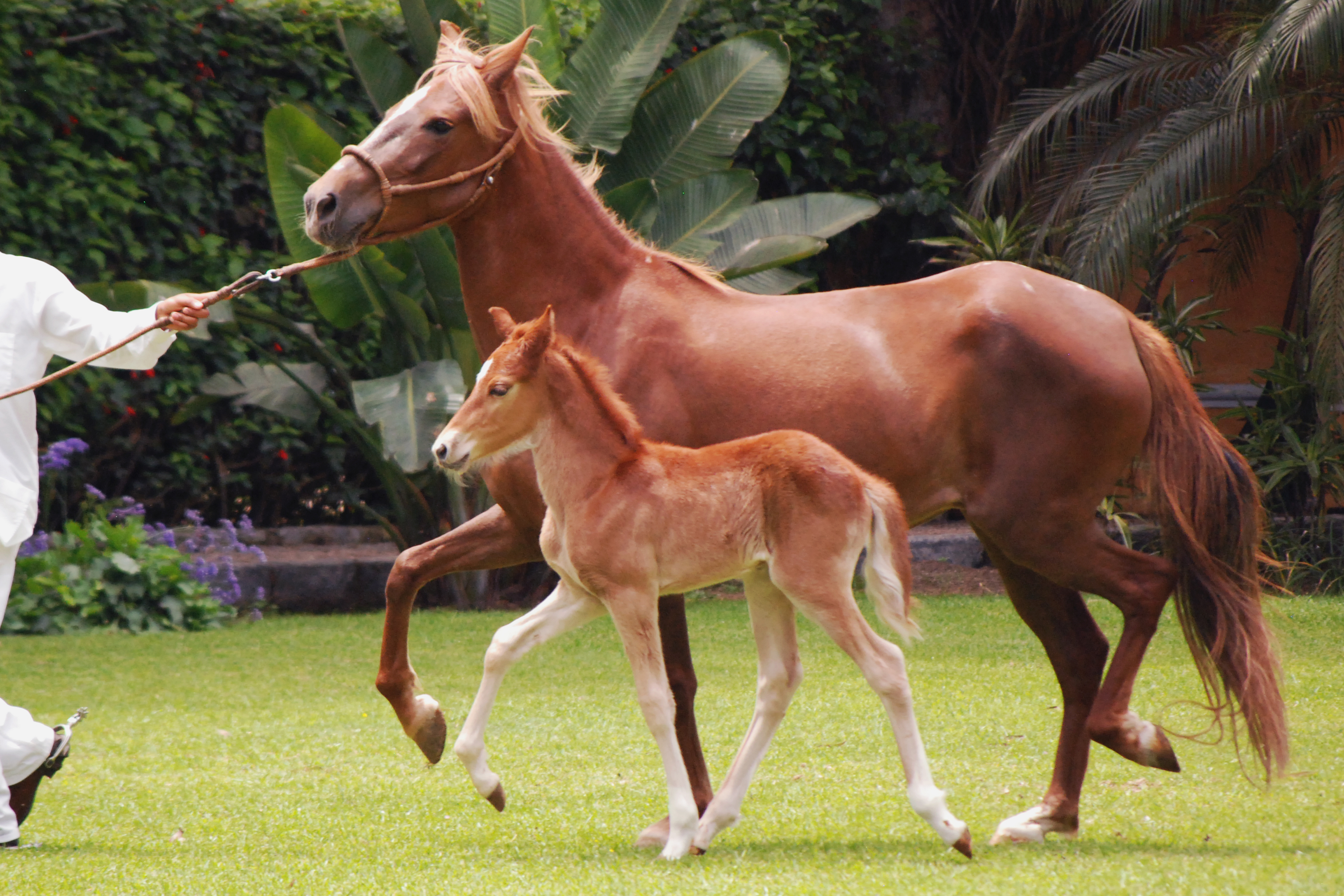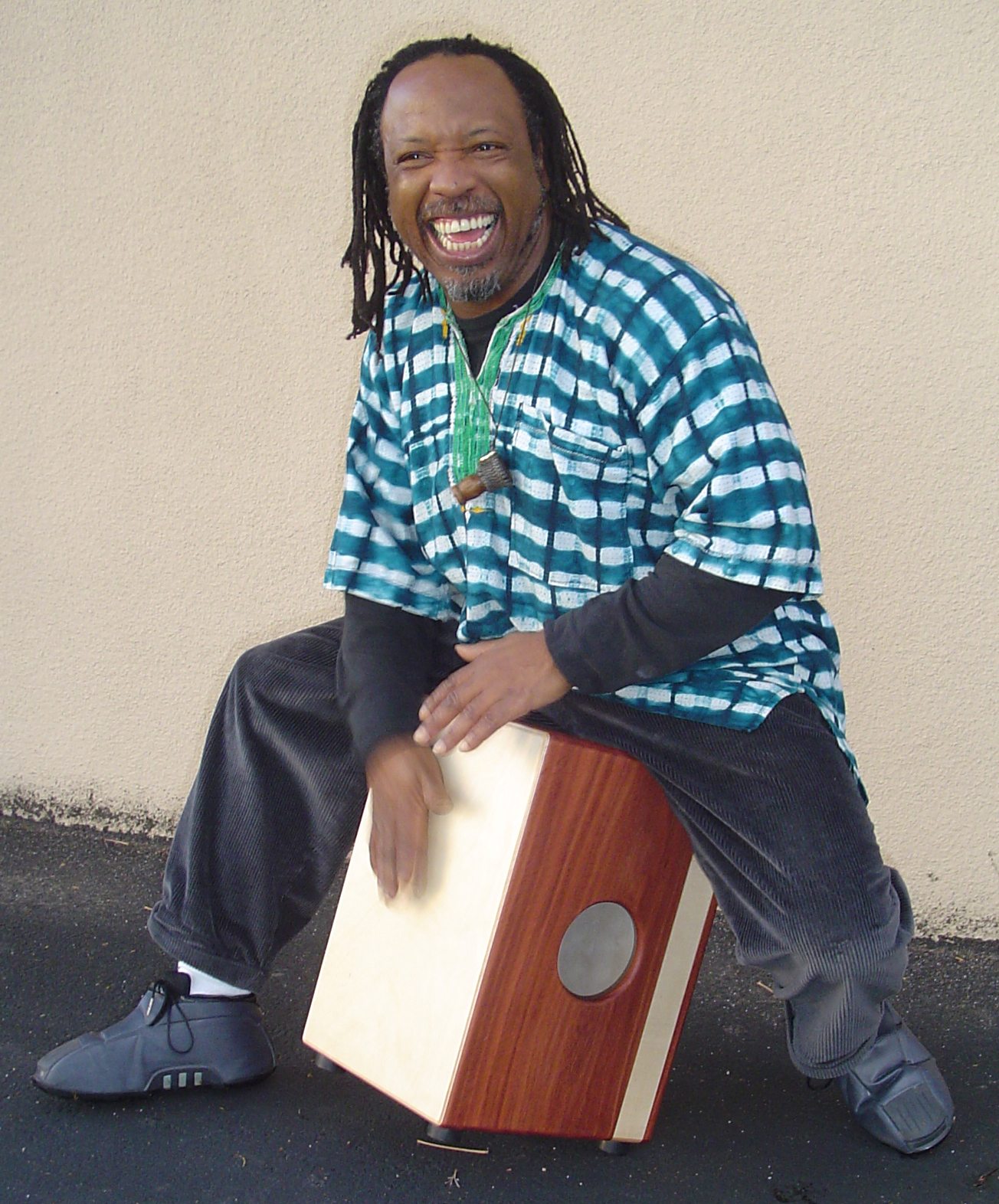|
Marinera
Marinera is a courtship dance that originated along the coastal regions of Peru, using handkerchiefs as props. The dance is a mix of Spanish contradanza and Andean zamacueca, and is a stylized reenactment of a courtship, showing a blend of the different cultures of Peru. The dance has gained recognition throughout South America and is known as the most prominent traditional dance of Peru. The city of Trujillo has been recognized as the national birthplace of the marinera since 1986. The Marinera Festival, a cultural event dedicated to marinera held in Trujillo, has held annual competitions of the dance since 1960. In 2012, the Congress of Peru observed nationally October 7 as a commemorative day for the marinera. The dance is traditionally accompanied by several instruments: cajón, clarinets, guitars, drums, and bugles. History The origins of the dance can be traced to Spanish, Moorish, Andean, and Gypsy rhythmic influences. Although the dance had informally been a ... [...More Info...] [...Related Items...] OR: [Wikipedia] [Google] [Baidu] |
Marinera Norteña
Marinera is a courtship dance that originated along the coastal regions of Peru, using handkerchiefs as props. The dance is a mix of Spanish contradanza and Andean zamacueca, and is a stylized reenactment of a courtship, showing a blend of the different cultures of Peru. The dance has gained recognition throughout South America and is known as the most prominent traditional dance of Peru. The city of Trujillo has been recognized as the national birthplace of the marinera since 1986. The Marinera Festival, a cultural event dedicated to marinera held in Trujillo, has held annual competitions of the dance since 1960. In 2012, the Congress of Peru observed nationally October 7 as a commemorative day for the marinera. The dance is traditionally accompanied by several instruments: cajón, clarinets, guitars, drums, and bugles. History The origins of the dance can be traced to Spanish, Moorish, Andean, and Gypsy rhythmic influences. Although the dance had informally been aro ... [...More Info...] [...Related Items...] OR: [Wikipedia] [Google] [Baidu] |
Trujillo Marinera Festival
Trujillo Marinera Festival is a Peruvian cultural event held annually in Trujillo city in January. The event focuses on a dance contest called the marinera, a typical dance of the city and of the country. The festival also presents parades, presentations and competitions of Peruvian paso horses. Both the marinera dance and the Peruvian paso horse have been declared to be part of the ''cultural heritage of the nation'' by the Peruvian government. This festival is one of the most important cultural events and representative of the country and Trujillo city has been recognized by the Peruvian government as the ''National Capital Marinera'' by Law Number 24447, of January 24, 1986. Description Trujillo is home to the marinera national competition each year. It is a typical dance of the city, organized by the Trujillo Club Libertad and it is performed in the last week of January. Many dance partners from different parts of the country and foreign guests come to the contest every year ... [...More Info...] [...Related Items...] OR: [Wikipedia] [Google] [Baidu] |
Trujillo, Peru
, population_note = , postal_code_type = Postal code , postal_code = 13001 , area_code = 044 , website Municipality of Trujillo, footnotes = Founded as ''Truxillo de Nueva Castilla'' (Trujillo of The New Castile) , image = , city_logo = , citylogo_size = , image_dot_map = , dot_mapsize = , dot_map_caption = , dot_x = , dot_y = , leader_title2 = , leader_name2 = , leader_title3 = , leader_name3 = , leader_title4 = , leader_name4 = , timezone = PET , utc_offset = −5 , timezone_DST = , ... [...More Info...] [...Related Items...] OR: [Wikipedia] [Google] [Baidu] |
Música Criolla
Música criolla or ''canción criolla'' is a varied genre of Peruvian music that exhibits influences from European, African and Andean music. The genre's name reflects the coastal culture of Peru, and the local evolution of the term '' criollo'', a word originally denoting high-status people of full Spanish ancestry, into a more socially inclusive element of the nation. From the presence of waltzes of Viennese origin, mazurkas, with the influence of French and Italian music from Europe, Lima's popular culture was shaped through the transformation and decantation of genres, transforming the musical genres and imported aesthetic patterns in such a way that, even assuming the fashions corresponding to each era, some musical forms were developed and developed that reach the end of the 20th century and identify what is Peruvian. Each historical moment, from the colonial period until now, was shaped in different ways in the musical culture of Peru through the musical instruments used ... [...More Info...] [...Related Items...] OR: [Wikipedia] [Google] [Baidu] |
Peru
, image_flag = Flag of Peru.svg , image_coat = Escudo nacional del Perú.svg , other_symbol = Great Seal of the State , other_symbol_type = Seal (emblem), National seal , national_motto = "Firm and Happy for the Union" , national_anthem = "National Anthem of Peru" , march = "March of Flags" , image_map = PER orthographic.svg , map_caption = , image_map2 = , capital = Lima , coordinates = , largest_city = capital , official_languages = Peruvian Spanish, Spanish , languages_type = Co-official languages , languages = , ethnic_groups = , ethnic_groups_year = 2017 , demonym = Peruvians, Peruvian , government_type = Unitary state, Unitary Semi-presidential system, semi-presidential republic , leader_title1 = President of Peru, President ... [...More Info...] [...Related Items...] OR: [Wikipedia] [Google] [Baidu] |
Peruvian Paso
The Peruvian Horse is a breed of light saddle horse known for its smooth ride. It is distinguished by a natural, four-beat, lateral gait called the ''paso llano.'' This breed is protected by the Peruvian government through Decree number 25919 of Peru enacted on November 28, 1992, and has been declared a Cultural Heritage of the Nation by the National Institute of Culture (INC). Due to the isolation suffered for about 400 years and the selection made by their breeders, this breed is very particular in their body proportions and an ambling gait or "paso llano" that is characteristic. It is typical of the northern Peruvian regions of the country from which it originated. Trujillo city is considered the cradle of typical Peruvian Horses. History Smooth-gaited horses, generally known as Palfreys, existed in the Middle Ages, and the Jennet in particular was noted for its ambling gaits. Peruvians trace their ancestry to these ambling Jennets; as well as to the Barb, which contr ... [...More Info...] [...Related Items...] OR: [Wikipedia] [Google] [Baidu] |
Cajón
A cajón (; "box", "crate" or "drawer") is a box-shaped percussion instrument originally from Peru, played by slapping the front or rear faces (generally thin plywood) with the hands, fingers, or sometimes implements such as brushes, mallets, or sticks. Cajones are primarily played in Afro-Peruvian music (specifically música criolla), but has made its way into flamenco as well. The term cajón is also applied to other box drums used in Latin American music, such as the Cuban cajón de rumba and the Mexican cajón de tapeo. Description Sheets of 13 to 19 mm (1/2 to 3/4 inch) thick wood are generally used for five sides of the box. A thinner sheet of plywood is nailed on as the sixth side, and acts as the striking surface or head. The striking surface of the cajón drum is commonly referred to as the ''tapa''. A sound hole is cut on the back side. The modern cajón may have rubber feet, and has several screws at the top for adjusting percussive timbre. Originally the ... [...More Info...] [...Related Items...] OR: [Wikipedia] [Google] [Baidu] |
Congress Of The Republic Of Peru
The Congress of the Republic of Peru ( es, Congreso de la República) is the unicameral body that assumes legislative power in Peru. Congress' composition is established by Chapter I of Title IV of the Constitution of Peru. Congress is composed of representatives who sit in congressional districts allocated to each region, as well as two special districts, Lima Province and Peruvian citizens living abroad, on a basis of population as measured by the Peruvian Census in multi-member districts. The number of voting representatives is fixed by the Constitution at 130. Pursuant to the 2017 Census, the largest delegation is that of Lima Province, with 36 representatives. Due to broadly interpreted impeachment wording in the 1993 Constitution of Peru, the Congress can impeach the President of Peru without cause, effectively making the legislature more powerful than the executive branch. Corruption is widespread throughout Congress as legislators use their office for parliamentary ... [...More Info...] [...Related Items...] OR: [Wikipedia] [Google] [Baidu] |
October 7
Events Pre-1600 * 3761 BC – The epoch reference date (start) of the modern Hebrew calendar. *1403 – Venetian–Genoese wars: The Genoese fleet under a French admiral is defeated by a Venetian fleet at the Battle of Modon. *1477 – Uppsala University is inaugurated after receiving its corporate rights from Pope Sixtus IV in February the same year. *1513 – War of the League of Cambrai: Spain defeats Venice. *1571 – The Battle of Lepanto is fought, and the Ottoman Navy suffers its first defeat. 1601–1900 *1691 – The charter for the Province of Massachusetts Bay is issued. *1763 – King George III issues the Royal Proclamation of 1763, closing Indigenous lands in North America north and west of the Alleghenies to white settlements. *1777 – American Revolutionary War: The Americans defeat British forces under general John Burgoyne in the Second Battle of Saratoga, also known as the Battle of Bemis Heights, compelling Burgoyne's eventu ... [...More Info...] [...Related Items...] OR: [Wikipedia] [Google] [Baidu] |
Andean Music
Andean music is a group of styles of music from the Andes region in South America. Original chants and melodies come from the general area inhabited by Quechuas (originally from Peru, Bolivia, Ecuador, Chile), Aymaras (originally from Bolivia), and other peoples who lived roughly in the area of the Inca Empire prior to European contact. This early music then was fused with Spanish music elements. It includes folklore music of parts of Peru, Bolivia, and Ecuador. Andean music is popular to different degrees across Latin America, having its core public in rural areas and among indigenous populations. The Nueva Canción movement of the 1970s revived the genre across Latin America and brought it to places where it was unknown or forgotten. Instruments The panpipes group include the sikú (or zampoña) and Antara. These are ancient indigenous instruments that vary in size, tuning, and style. Instruments in this group are constructed from aquatic reeds found in many lakes in the ... [...More Info...] [...Related Items...] OR: [Wikipedia] [Google] [Baidu] |
List Of Minor Secular Observances
Lists of holidays by various categorizations. Religious holidays Abrahamic holidays (Middle Eastern) Jewish holidays * Chag HaMatzot (Feast of Unleavened Bread – 7 days of consumption of matzo with wine and avoidance of leavened foods) *Hanukkah (Feast of Dedication; Also called the Festival of Lights – Commemoration of the rededication of the Jerusalem Temple) * Pesach (Passover – Deliverance of Jews from slavery in Egypt) ** Lag BaOmer (A holiday celebrated on the 33rd day of the Counting of the Omer, which occurs on the 18th day of the Hebrew month of Iyar) * Purim (Feast of Lots – Deliverance of Jews in Persia from extermination by Haman) * Reishit Katzir (Feast of Firstfruits – Collecting and waving of grain bundles (barley or wheat); Occurs during the 7 days of unleavened bread after the Sabbath) *Rosh Hashanah (Jewish New Year – First day of Tishrei every year) * Shabbat (The 7th Day Sabbath – The day of rest and holiest day of the week, Saturday) ... [...More Info...] [...Related Items...] OR: [Wikipedia] [Google] [Baidu] |
South America
South America is a continent entirely in the Western Hemisphere and mostly in the Southern Hemisphere, with a relatively small portion in the Northern Hemisphere at the northern tip of the continent. It can also be described as the southern Subregion#Americas, subregion of a single continent called Americas, America. South America is bordered on the west by the Pacific Ocean and on the north and east by the Atlantic Ocean; North America and the Caribbean Sea lie to the northwest. The continent generally includes twelve sovereign states: Argentina, Bolivia, Brazil, Chile, Colombia, Ecuador, Guyana, Paraguay, Peru, Suriname, Uruguay, and Venezuela; two dependent territory, dependent territories: the Falkland Islands and South Georgia and the South Sandwich Islands; and one administrative division, internal territory: French Guiana. In addition, the ABC islands (Leeward Antilles), ABC islands of the Kingdom of the Netherlands, Ascension Island (dependency of Saint Helena, Asce ... [...More Info...] [...Related Items...] OR: [Wikipedia] [Google] [Baidu] |






